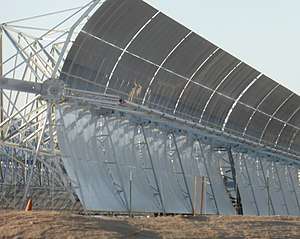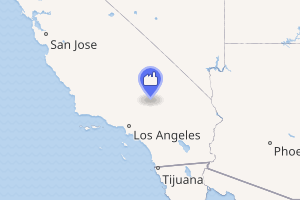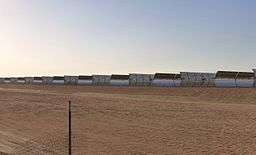Mojave Solar Project
The Mojave Solar Project (MSP) is a concentrated solar power (CSP) facility in the Mojave Desert in California, about 20 miles (32 km) northwest of Barstow. Surrounding the hamlet of Lockhart, Mojave Solar is adjacent to Harper Lake and the SEGS VIII–IX solar plant. The site was originally reserved for the planned, never built, SEGS IX and XII. For 15 years following its construction in 1990, this was the largest commercial solar power plant in the world, generating around 160 megawatts at its peak. It is one of three separately owned sites within 40 miles (64 km) of one another, that make up the nine solar fields in the Solar Electric Generating System (SEGS #1 and 2 are at Daggett, and #3 through 7 are at Kramer Junction). Harper Lake was the last of these built, and is designated as SEGS #8 and 9. It is still online, but has been surpassed by other newer facilities, including the Mojave Solar Project.[1] MSP, with a combined nameplate capacity of 250 MW (gross 280 MW), is made of two, independently operable, solar fields. The power plant cost an estimated $1.6 billion in total and entered commercial operation in December 2014.[2] The developer, Abengoa, has successfully secured a $1.2 billion loan guarantee from the US government for the project.[3][4][5] The plant is expected to generate 617,000 MWh of power annually, enough power for more than 88,000 households and to prevent the emission of over 430 kilotons of CO2 a year.[6] Pacific Gas & Electric has agreed to a 25-year power purchase agreement.[7]
| Mojave Solar Project | |
|---|---|
 | |

| |
| Country | United States |
| Location | Mojave Desert, California |
| Coordinates | 35°0′40″N 117°19′30″W |
| Status | Operational |
| Construction began | September 2011 |
| Commission date | December 1, 2014 |
| Solar farm | |
| Type | CSP |
| CSP technology | Parabolic trough |
| Collectors | 2256 (SCAs) |
| Total collector area | 1,559,347 square metres (385.323 acres) |
| Site resource | 2,685 kW·h/m2/yr |
| Site area | 1,765 acres (714 ha) |
| Power generation | |
| Units operational | 2 x 140 MWe (gross) |
| Nameplate capacity | 250 MW |
| Capacity factor | 27.7% (2015–2018) |
| Annual net output | 582 GW·h |
| External links | |
| Website | mojave solar project |
| Commons | Related media on Commons |
The plant was commissioned on 1 December 2014.[8]
Technology

Using the desert's solar thermal energy, the facility generates steam in solar steam generators, which expands through a steam turbine generator to produce electrical power from twin, independently operable solar fields, each feeding a 125 MW power island. Generation is provided 100% from sun, no supplement from fossil-based energy sources. There is a gas-fired auxiliary boiler, for each field, only to provide equipment and heat-transfer fluid (HTF) freeze protection, when temperatures fall below 54 °F (12 °C).

The power cycle is a Rankine-with-reheat thermodynamic cycle from heat supplied via heat-transfer fluid, solar field heated up to 740 °F (393 °C). When operating, the transfer fluid enters the solar field at about 520 °F (271 °C). The steam generator steam exit temperature is about 720 °F (382 °C).
Each field utilizes 1128 solar collector arrays (SCA) sited on about 710 acres (290 ha). Each SCA, model E2 from Abengoa (derived from Luz's LS-3), is 125 metres (410 ft) long and is made of 10 solar collector elements (SCE), 12 metres (39 ft) long each and 5.76 metres (18.9 ft) aperture. The E2 steel frame collector with monolithic glass reflector panels, yields a total aperture area of 691.2 square metres (7,440 sq ft). That makes a total of 779,674 square metres (8,392,340 sq ft) aperture each solar field, 1,559,347 square metres (16,784,670 sq ft) total for the plant, operating about 3,024 hours per year.
Cooling is provided by wet cooling towers; water for the towers and solar collector washing, is supplied from onsite groundwater wells. Water from condensed steam exits the cooling tower pump at about 80 °F (27 °C), before cycling back to the steam generator.
Production
Mojave Solar Project production is as follows (values in MW·h).[9]
| Year | Jan | Feb | Mar | Apr | May | Jun | Jul | Aug | Sep | Oct | Nov | Dec | Total |
|---|---|---|---|---|---|---|---|---|---|---|---|---|---|
| 2015 | 4,816 | 28,254 | 49,104 | 57,830 | 49,132 | 43,618 | 64,353 | 63,367 | 57,559 | 37,406 | 32,818 | 15,319 | 503,576 |
| 2016 | 4,635 | 42,348 | 41,890 | 54,991 | 75,569 | 80,338 | 87,565 | 79,153 | 68,245 | 45,346 | 30,315 | 14,512 | 624,907 |
| 2017 | 6,055 | 22,196 | 54,504 | 61,408 | 76,179 | 78,362 | 74,443 | 58,478 | 63,663 | 55,255 | 21,818 | 21,669 | 594,030 |
| 2018 | 21,688 | 37,489 | 48,733 | 42,966 | 78,035 | 84,956 | 70,267 | 71,788 | 74,929 | 51,473 | 13,976 | 8,880 | 605,180 |
| Total | 2,327,693 | ||||||||||||
Maximum production was planned at 617,000 MW·h per year.[10]
See also
References
- "The Center for Land Use Interpretation". Clui.org. Retrieved 18 July 2018.
- csp-world.com Abengoa's Mojave 250 MW CSP plant enters commercial operation, 2 December 2014
- "US government backs Abengoa's solar project with $1.2 billion loan guarantee". Energy Efficiency News. 19 September 2011. Archived from the original on 29 November 2011. Retrieved 8 February 2012.
- "Abengoa Solar, Inc. (Mojave Solar)". Loan Guarantee Program. DOE. Archived from the original on January 27, 2012. Retrieved February 7, 2012.
- Abengoa Solar Abengoa Solar - The Mojave Solar Project Archived 2013-06-19 at the Wayback Machine
- "Loans - Award Summary: Mojave Solar LLC". U.S. Government. Archived from the original on 25 February 2013. Retrieved 26 August 2013.
- "Advice Letters 3876-E and 3876-E-A" (PDF). California Public Utilities Commission. January 11, 2012. Retrieved February 7, 2012.
- "Abengoa puts 250 MW CSP array online in California". Industry Dive. Retrieved June 28, 2015.
- "Mojave Solar Project, Monthly". Electricity Data Browser. Energy Information Administration. Retrieved March 8, 2017.
- "Mojave". Loan Programs Office. www.energy.gov. U.S. Department of Energy. 2011. Archived from the original on 27 June 2017. Retrieved 12 September 2019.
Mojave is expected to generate 617,000 megawatt-hours of clean energy and prevent 329,000 metric tons of carbon dioxide emissions annually
External links
- "Mojave Solar Project". Plants under construction. Abengoa Solar. Archived from the original on June 21, 2012. Retrieved February 7, 2012.
- "Abengoa Mojave Solar Project". SolarPACES. National Renewable Energy Laboratory (NREL), U.S. Dept. of Energy (DOE). October 20, 2011. Retrieved February 7, 2012.
- "Abengoa Mojave Solar Project Power Plant Licensing Case". California Energy Commission. July 18, 2011. Retrieved February 7, 2012.
- "Abengoa Mojave Solar Power Plant (CACA 52096)". Renewable Energy Priority Projects. Bureau of Land Management (BLM), Dept. of the Interior (DOI). July 15, 2011. Archived from the original on January 14, 2012. Retrieved February 7, 2012.